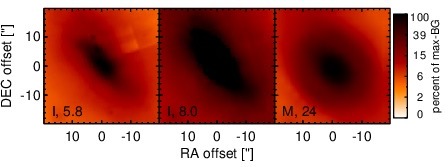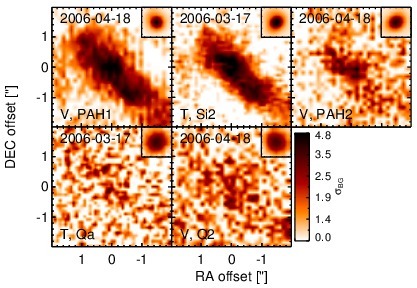Sasmirala Individual Information for NGC 4945
Description
NGC 4945 is a nearby almost edge-on spiral galaxy (distance of D = 3.7 ± 0.8 Mpc; NED redshift-independent median) with a highly obscured nucleus containing both a starburst and an AGN [moorwood_extended_1994, moorwood_starburst_1996]. In the optical, the nucleus is almost completely obscured and appears as an H II nucleus [moorwood_starburst_1996, goulding_towards_2009]. The [O III] emission seems to be completely obscured in the nuclear region [moorwood_starburst_1996]. On the other hand, the AGN is evident in hard X-rays, where it is one of the flux-brightest and most variable sources with very complex spectral properties (e.g.,, [yaqoob_nature_2012, marinucci_x-ray_2012]). It appears as a compact radio source at subarcsecond scales [elmouttie_radio_1997], and an additional jet-like structure extending ~ 5 pc southwest has been detected recently as well [lenc_sub-parsec_2009]. The nucleus also hosts water mega-maser emission on subparsec scales (PA~ 45∘; [dos_santos_detection_1979, greenhill_distribution_1997]). The nucleus is surrounded by a starburst disc with ~ 11arcsec ~ 200 pc diameter orientated in the same direction as the galactic disc [marconi_elusive_2000]. The first ground-based MIR observations were performed by [moorwood_infrared_1984] and followed up with ISO observations [rigopoulou_large_1999, spoon_mid-infrared_2000, lutz_relation_2004]. The corresponding MIR spectra show deep silicate 10 μm absorption and indicate heavy absorption even in the MIR [spoon_mid-infrared_2000, krabbe_n-band_2001]. The first ground-based N-band images were obtained with ESO 3.6 m/TIMMI in 1996 [marconi_elusive_2000] and with ESO 2.2 m/MANIAC in 1998 [krabbe_n-band_2001]. These show a compact nucleus embedded within elongated emission parallel to the galaxy major axis. A similar galactic morphology is evident in the Spitzer/IRAC and MIPS images however with lower spatial resolution. Moreover, the nucleus is saturated in the IRAC 5.8 and 8.0 μm PBCD images and, thus, not analysed. The Spitzer/IRS LR spectrum verifies the deep silicate 10 μm absorption and in addition indicates silicate 18 μm absorption, weak PAH emission and a in general shallow red spectral slope in νFν-space (see also [brandl_mid-infrared_2006, bernard-salas_spitzer_2009, goulding_towards_2009, perez-beaupuits_deeply_2011]). Thus, the arcsecond-scale MIR SED has AGN/starburst composite characteristics. The nuclear region of NGC 4945 was observed with T-ReCS in the Si2 and Qa filters in 2006 (partly published in [imanishi_subaru_2011]), and with VISIR in two narrow N and one Q-band filter also in 2006 (unpublished, to our knowledge). The N-band images show a weakly detected elongated structure (major axis diameter ~ 3arcsec ~ 54 pc; PA~ 45∘) with a compact component located roughly in the middle. We assume this to be the location of the AGN and measure the unresolved nuclear component with manual PSF-scaling. The resulting fluxes are on average ~ 81% lower than the Spitzer spectrophotometry. In the Q-band images, the MIR structure is barely visible, and we treat the measured fluxes as upper limits (but see [imanishi_subaru_2011]). Owing to the composite nature and the nucleus that cannot be clearly separated from the surrounding emission, our subarcsecond MIR fluxes have to be regarded as upper limits on any AGN-powered MIR emission in NGC 4945. The nuclear MIR coverage is not sufficient to distinguish, whether at subarcsecond resolution resolution the silicate absorption is deeper or the continuum emission is lower. We conclude that the observed MIR emission of the central ~ 70 pc in NGC 4945 is star-formation dominated in agreement with previous results [spoon_mid-infrared_2000].
- [bernard-salas_spitzer_2009] J. Bernard-Salas, H. W. W. Spoon, V. Charmandaris, V. Lebouteiller, D. Farrah, D. Devost, B. R. Brandl, Yanling Wu, L. Armus, L. Hao, G. C. Sloan, D. Weedman, and J. R. Houck. A spitzer high-resolution mid-infrared spectral atlas of starburst galaxies . ApJS , 184 pp. 230–247, October 2009.
- [brandl_mid-infrared_2006] B. R. Brandl, J. Bernard-Salas, H. W. W. Spoon, D. Devost, G. C. Sloan, S. Guilles, Y. Wu, J. R. Houck, D. W. Weedman, L. Armus, P. N. Appleton, B. T. Soifer, V. Charmandaris, L. Hao, J. A. Marshall Higdon, and T. L. Herter. The mid-infrared properties of starburst galaxies from spitzer-IRS spectroscopy . ApJ , 653 pp. 1129–1144, December 2006.
- [dos_santos_detection_1979] P. M. Dos Santos and J. R. D. Lepine. Detection of strong H2O emission from galaxy NGC4945 . Nature , 278 pp. 34, March 1979.
- [elmouttie_radio_1997] M. Elmouttie, R. F. Haynes, K. L. Jones, M. Ehle, R. Beck, J. I. Harnett, and R. Wielebinski. The radio continuum structure of the edge-on spiral galaxy NGC 4945 . MNRAS , 284 pp. 830–838, February 1997.
- [goulding_towards_2009] A. D. Goulding and D. M. Alexander. Towards a complete census of AGN in nearby galaxies: a large population of optically unidentified AGN . MNRAS , 398 pp. 1165–1193, September 2009.
- [greenhill_distribution_1997] L. J. Greenhill, J. M. Moran, and J. R. Herrnstein. The distribution of h 2O maser emission in the nucleus of NGC 4945 . ApJL , 481 pp. L23, May 1997.
- [imanishi_subaru_2011] Masatoshi Imanishi, Keisuke Imase, Nagisa Oi, and Kohei Ichikawa. Subaru and gemini high spatial resolution infrared 18 μm imaging observations of nearby luminous infrared galaxies . AJ , 141 pp. 156, May 2011.
- [krabbe_n-band_2001] Alfred Krabbe, Torsten Böker, and Roberto Maiolino. N-band imaging of seyfert nuclei and the mid-infrared-x-ray correlation . ApJ , 557 pp. 626–636, August 2001.
- [lenc_sub-parsec_2009] E. Lenc and S. J. Tingay. The sub-parsec scale radio properties of southern starburst galaxies. II. supernova remnants, the supernova rate, and the ionised medium in the NGC 4945 starburst . AJ , 137 pp. 537–553, January 2009.
- [lutz_relation_2004] D. Lutz, R. Maiolino, H. W. W. Spoon, and A. F. M. Moorwood. The relation between AGN hard x-ray emission and mid-infrared continuum from ISO spectra: Scatter and unification aspects . A&A , 418 pp. 465–473, May 2004.
- [marconi_elusive_2000] A. Marconi, E. Oliva, P. P. van der Werf, R. Maiolino, E. J. Schreier, F. Macchetto, and A. F. M. Moorwood. The elusive active nucleus of NGC 4945 . A&A , 357 pp. 24–36, May 2000.
- [marinucci_x-ray_2012] A. Marinucci, G. Risaliti, Junfeng Wang, E. Nardini, M. Elvis, G. Fabbiano, S. Bianchi, and G. Matt. The x-ray reflector in NGC 4945: a time- and space-resolved portrait . MNRAS , 423 pp. L6–L10, June 2012.
- [moorwood_extended_1994] A. F. M. Moorwood and E. Oliva. Extended infrared line emission excited by starburst and seyfert activity in NGC 3256 and NGC 4945 . ApJ , 429 pp. 602–611, July 1994.
- [moorwood_infrared_1984] A. F. M. Moorwood and I. S. Glass. Infrared activity in circinus and NGC 4945 - two galaxies containing luminous H2O masers . A&A , 135 pp. 281–288, June 1984.
- [moorwood_starburst_1996] A. F. M. Moorwood, P. P. van der Werf, J. K. Kotilainen, A. Marconi, and E. Oliva. Starburst superwind and LINER activity in NGC4945 . A&A , 308 pp. L1, April 1996.
- [perez-beaupuits_deeply_2011] J. P. Pérez-Beaupuits, H. W. W. Spoon, M. Spaans, and J. D. Smith. The deeply obscured AGN of NGC 4945. i. spitzer-IRS maps of [ne v], [ne II], h2 0-0 s(1), s(2), and other tracers . A&A , 533 pp. 56, September 2011.
- [rigopoulou_large_1999] D. Rigopoulou, H. W. W. Spoon, R. Genzel, D. Lutz, A. F. M. Moorwood, and Q. D. Tran. A large mid-infrared spectroscopic and near-infrared imaging survey of ultraluminous infrared galaxies: Their nature and evolution . AJ , 118 pp. 2625–2645, December 1999.
- [spoon_mid-infrared_2000] H. W. W. Spoon, J. Koornneef, A. F. M. Moorwood, D. Lutz, and A. G. G. M. Tielens. Mid-infrared ISO spectroscopy of NGC 4945 . A&A , 357 pp. 898–908, May 2000.
- [yaqoob_nature_2012] Tahir Yaqoob. The nature of the compton-thick x-ray reprocessor in NGC 4945 . MNRAS , 423 pp. 3360–3396, July 2012.
Images

Optical image (DSS, red filter). Displayed are the central 4 arcmin with North being up and East to the left. The colour scaling is linear with white corresponding to the median background (BG) and black to the 0.01% pixels with the highest intensity.

Spitzer MIR images. Displayed are the inner 40 arcsec with North being up and East to the left. The colour scaling is logarithmic with white corresponding to median BG and black to the 0.1% pixels with the highest intensity. The label in the bottom left states instrument and central wavelength of the filter in micron (I: IRAC, M: MIPS).

Subarcsecond-resolution MIR images sorted by increasing filter central wavelength. Displayed are the inner 4 arcsec with North being up and East to the left. The colour scaling is logarithmic with white corresponding to median BG and black to the 75% of the highest intensity of all images in units of sig_bg. The inset image (where present; either bottom or top right) shows the central arcsecond of the PSF from the calibrator star, scaled to match the science target. The labels in the bottom left state instrument and filter names (C: COMICS, M: Michelle, T: T-ReCS, V: VISIR).
SEDs


MIR SED. The description of the symbols in all the SED plots (where present) is the following: Grey crosses and solid lines mark the Spitzer/IRAC, MIPS and IRS data. The colour coding of the other symbols is as follows: green for COMICS, magenta for Michelle, blue for T-ReCS and red for VISIR data. Darker-coloured solid lines mark spectra of the corresponding instrument. The black filled circles mark the nuclear 12 and 18 micron continuum emission estimate from the data (where present). The ticks on the top axis mark positions of common MIR emission lines, while the light grey horizontal bars mark wavelength ranges affected by the silicate 10 and 18 micron features.